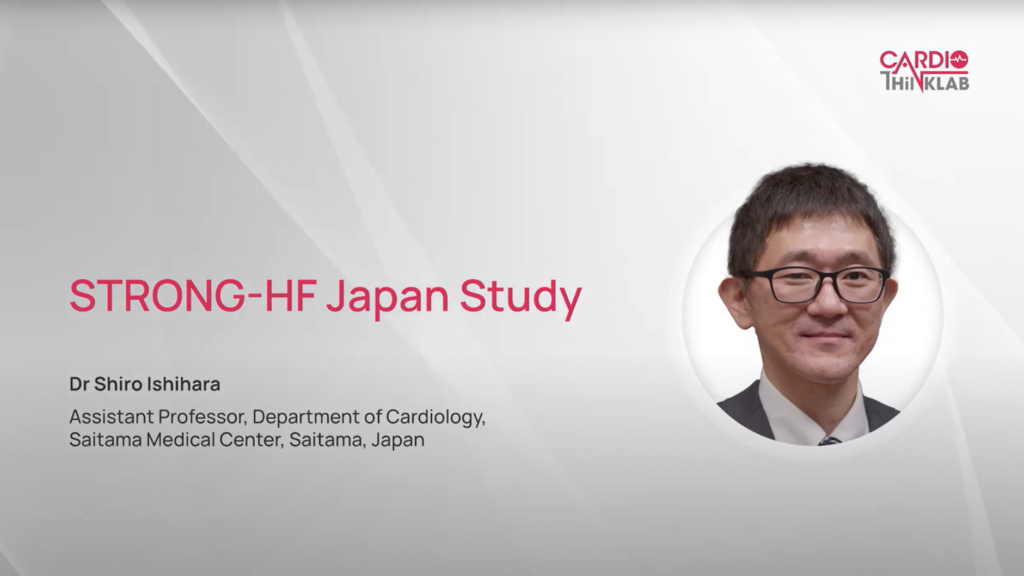This Local Stories series consists of a 7 part video interview with Dr Koichi Node.
Question 1: The current status and the unmet needs concerning cardiovascular disease (CAD focus) in T2DM patients in Japan?
Firstly, in Asian countries including Japan, the prevalence of diabetes and obesity has been increasing due to change of diet and lifestyle. Regarding history of cardiovascular disease in Japan, there were few cases of myocardial infarction and many cases of cerebral infarction, but the incidence of myocardial infarction and other diseases including macrovascular disorders has been increasing due to the increase in obesity and diabetes and the changes in dietary habits as mentioned earlier.
Diabetes is responsible for the increased incidence of myocardial infarction and arteriosclerosis. On the other hand, myocardial infarction in diabetic patients is said to involve more advanced vascular disorders compared with hypertension or hyperlipidemia associated with arteriosclerosis. Specifically, if diabetes is of long duration with an onset of more than 10 years, arteriosclerosis develops due to hardening of the vascular smooth muscle and calcification of the blood vessels. Therefore, when we see patients with diabetes, we often observe complications such as myocardial infarction and angina with coronary calcification.
Vascular sclerosis and arteriosclerosis in these patients do not improve in a short time with strict blood glucose control only. For example, when LDL cholesterol is reduced using statins, events of arteriosclerosis and unstable plaque formation due to hyperlipidemia are inhibited in a relatively short period, in about six months to one year. However, in diabetes, for example, even if blood glucose is strictly controlled and improved by lowering HbA1c, it probably takes more than 10 years to prevent such events. The “legacy effect” which was reported in the DCCT, UKPDS, and ACCORD studies showed that it would take about 15 years to evaluate the effect of preventing adverse events.
Early intervention is proposed as a way to address these issues. For early intervention, we need to detect arteriosclerotic disease at an early stage. Therefore, early assessment of angina and arteriosclerosis will be necessary in patients with diabetes. This is one of the problems in managing cardiovascular disease in diabetes.
The second problem with myocardial infarction in diabetes is the absence of symptoms.
In patients with diabetes, neurological disorder occurs as a complication. Out of the neurological disorder, peripheral neuropathy is one of the three major complications. This is associated with myocardial ischemia without symptoms of pain. It occurs frequently especially in elderly patients and is difficult to detect due to lack of symptoms. This is the second problem.
Therefore, rather than relying on symptoms, we need to detect arteriosclerosis early in diabetic patients.I think these are the major problems currently in the evaluation and management of diabetic patients with CVD.
Get the latest updates in your inbox
Stay InformedQuestion 2: What triggered the development of this consensus statement between the Japanese Circulation Society and Japan Diabetes Society?
As I mentioned, the three traditional major complications of diabetes, retinopathy, neuropathy, and nephropathy, are organ disorders. These complications are microangiopathy. In other words, the damage of blood vessels with a diameter of several hundred micrometers was considered as a major complication.
However, macroangiopathy (damage of large vessels) such as myocardial infarction and cerebral infarction has been increasing recently, and we need to evaluate macroangiopathy in addition to the three major complications. Doctors who examine and treat myocardial infarction and angina are cardiologists. Doctors who see cerebral infarction/stroke cases are neurologists and brain surgeons. Therefore, for early evaluation of macroangiopathy in patients with diabetes, cooperation of cardiologists and neurologists is needed, and cooperation of both clinical departments is needed in clinical practice.
On the other hand, there is no doubt that blood glucose control is effective in patients with cardiovascular disease. Accordingly, cooperation and collaboration of specialists of diabetes are needed to treat diabetes in cardiovascular patients, and two-way cooperation of both clinical departments are naturally needed in the evaluation and management of cardiovascular diseases in diabetes and the management of diabetes at the department of cardiovascular medicine.
On the other hand, the department of diabetology and the department of cardiovascular medicine take up quite a large part of the internal diseases. The responsibility of both clinical departments has been increasing with time.
To be honest, both clinical departments and the academic societies have never collaborated before. The Japanese Circulation Society has published many guidelines. For example, we have published treatment guidelines for heart failure, myocardial infarction, arrhythmia, and various other diseases, but until now, the Japan Diabetes Society has never participated or collaborated in these guideline development. The guideline for the treatment of diabetes is also a major guideline issued by the Japan Diabetes Society. Actually, the development of the guidelines of the Japan Diabetes Society involved cardiovascular-related academic societies, such as the Japanese Society of Hypertension and the Japan Atherosclerosis Society, as cooperative academic societies. However, the Japanese Circulation Society has never participated. There was almost no collaboration between the two academic societies.
Being the chairperson of the prevention committee of the Japanese Circulation Society, I think perhaps cardiologists have been actively involved in the treatment of hypertension and hyperlipidemia, hence compared to the past, controlling blood pressure and cholesterol levels has become better. Considerably, increased medication options such as ARB, ACE inhibitor, and calcium antagonist, is one of the contributors. Regarding hyperlipidemia, increased use of statins and cholesterol absorption inhibitors especially, helped us reach the guideline-compliant goals to some extent.
In the treatment of diabetes, it was difficult to lower HbA1c to the target level with SU, insulin, α-GI or glitazone until about 5 years ago.
Under such circumstances, we thought collaboration between the two academic societies would be necessary to ensure prevention of cardiovascular diseases. We decided to establish a joint committee of the Japanese Circulation Society and the Japan Diabetes Society.
From the Japanese Circulation Society, three members joined; Dr. Murohara, and Dr. Hiroshi Ito of Okayama and myself. From the Japan Diabetes Society, three members joined; Dr. Inagaki of Kyoto University, Dr. Araki of Kumamoto University, and Dr. Ueki of the University of Tokyo. The joint committee was initiated with six members.
A joint statement by ADA, AHA, and ACC that is issued in Europe and the United States was considered. In ESC, joint statements and guidelines between ESC and EASD have been frequently issued. In Japan, there have been no joint statements or guidelines by JCS and JDS, so we decided to create a joint statement and start from there. We thought developing a guideline from scratch would not be easy, so we decided to create something in the form of a statement first.

Question 3: Key highlights of the consensus statement (CAD & AF focus)
As I said earlier, the evaluation and diagnosis of cardiovascular diseases in diabetic patients will be the first issue. Therefore, we divided the statement into three parts and considered how to evaluate arteriosclerotic lesions in patients with diabetes.
It starts with symptoms, ECG, and diagnostic imaging. In particular, we emphasized that patients should undergo ECG at least once a year even if he is asymptomatic and should be followed up carefully at least once a year to uncover any chest symptoms. Another point is that when patients have hypertension, CKD, or family history, for example, a vascular function test is suggested if possible. For vascular function tests, PWV,(Pulse Wave Velocity) CAVI (Cardio Ankle Vascular Index), and ABI (Ankle Brachial Index) are specifically suggested. PWV and CAVI are tests to check the vascular stiffness of the blood vessels, which will be used for the evaluation. ABI is a test to evaluate peripheral arteriosclerosis obliterans.
We recommend these tests. If ABI is less than 0.9, we advise to refer the patient to the department of cardiovascular medicine.
We also recommend plain coronary CT angiography. Recently contrast-enhanced coronary CT angiography is often being used. However it is difficult to perform for screening purposes because a considerable amount of contrast agent is required and the radiation exposure is also substantial. Consequently, we recommend plain coronary CT angiography first. For example, in CT angiography, an Agaston score of 100 or higher indicates a high risk, and a score of 400 or higher indicates a very high risk, as a calcification score. We advise to refer the patient to the department of cardiovascular medicine depending on the grade of calcification.
We organized an easy-to-understand scheme of patient referral to the department of cardiovascular medicine to perform contrast-enhanced CT angiography, exercise stress test, and scintigraphy when any abnormality is detected by vascular function evaluation or plain CT angiography.
Another thing we emphasized this time is recommendations to find atrial fibrillation in patients with diabetes. Why this is important is because untreated atrial fibrillation becomes a major risk for cerebral infarction. Therefore, if atrial fibrillation is found in diabetic patients, anticoagulant therapy is indicated because CHADS2-VASc score will be 1 or 2 even if it is PAF (paroxysmal atrial fibrillation).
We suggest anticoagulant therapy based on a thorough evaluation of risks of fatal cerebral infarction or cerebral infarction inflicting permanent damage that may be caused by insufficient anticoagulant therapy, even if the seizure occurs only once a month and lasts for only one minute, because the thrombus arises from a very large source of embolus. In addition, untreated tachycardia AF (atrial fibrillation) in diabetic patients will most likely develop into heart failure.
Therefore, appropriate heart rate control is necessary. Heart rate should be properly controlled with an antiarrhythmic drug or beta blocker. We emphasize our recommendation to refer the patient to a cardiologist if atrial fibrillation is detected, even if it is PAF (paroxysmal atrial fibrillation). Otherwise, cerebral infarction or heart failure will occur.
These are what to look for when assessing cardiovascular diseases in patients with diabetes.
Meanwhile, Dr. Inagaki of Kyoto University was in charge of diagnosis of diabetes in patients with cardiovascular diseases. For example, we emphasize the importance of IGT evaluation based on appropriate OGTT and diagnosing diabetes that is difficult to be diagnosed based on fasting blood glucose or HbA1c alone. This may be an important point. I will talk about heart failure later.
Another important point is the collaboration between the department of cardiovascular medicine and the department of diabetology. Chapter 3 provides specific referral advice, such as which type of patients with pathological conditions should be referred to a cardiologist or a diabetologist. It may also be important.
Question 4: The current status and unmet needs concerning heart failure in T2DM patients
I may have mentioned it when I talked about the current situation of cardiovascular diseases, and that the number of patients with cardiovascular diseases is increasing overall. However, the incidence of myocardial infarction is increasing while the number of deaths due to myocardial infarction is decreasing.
That is why the acute-phase treatment has progressed. Since the treatment such as PCI and acute-phase PCPS has improved, deaths in acute-phase are decreasing.
However, the number of deaths from heart failure is increasing. The mortality due to heart failure has increased because more patients survive with the treatment of myocardial infarction, and the elderly population has been increasing. Therefore, to decrease the mortality rate in the Japanese population, we need to decrease the incidence of heart failure.
In that sense, reducing the mortality due to heart failure is important for healthcare in Japan.
Another reason for the increase in incidence of heart failure is the increase of obesity and diabetes, in addition to the increase of the elderly population and the promotion of life prolongation of patients with myocardial infarction. In this way, the third point is that proper management of diabetes and correction of obesity will reduce the mortality due to heart failure, the mortality due to cardiovascular disease, and eventually the mortality of Japanese people. From this viewpoint, treatment of diabetes is very important.
In addition, patients with diabetes have more diastolic dysfunction compared with patients with heart failure due to myocardial infarction. It may result in cardiomyocyte hypertrophy in patients with hyperglycemia, insulin resistance leading to hyperinsulinemia or marked glucose fluctuation.
Alternatively, fibrosis occurs, causing diastolic dysfunction. It is a huge problem.
Diastolic heart failure is a difficult disease, which is hard to diagnose. It is often overlooked and may turn into systolic heart failure without being revealed. Alternatively, fatal arrhythmia may occur in diastolic heart failure, resulting in sudden death. We must consider how to diagnose hidden diastolic heart failure in diabetic patients.
The joint statement also proposes how to identify heart failure in patients with diabetes as a scheme.
First of all, heart failure is diagnosed based on symptoms just as diabetes is. Diagnosis cannot be made without a certain degree of symptoms. Therefore, a thorough clinical examination with history taking should be done first. For example, we emphasize the importance of asking the patient if he has symptoms such as general malaise, feeling tired when lying down, frequency of micturition at night, and feeling tired when bending forward. This also includes pathological findings on clinical examination, such as that audible S3 or S4 in a patient aged 40 or older, and that congestion is documented when the jugular vein is distended while sitting.
What do we do when one or two of such findings are discovered?
The key point to consider is that non-specialists can also make this evaluation easily. Although sometimes to make a diagnosis of heart failure is challenging even for cardiologists. Even for cardiologists, it could be difficult to determine if fatigue is caused by asthma or due to heart failure, and if the breathing difficulty is caused by COPD or due to heart failure. The diagnosis needs to be made in the simplest manner possible.
We suggest measuring blood biomarkers if the patient has any symptoms or heart failure is suspected.
One of the biomarkers is BNP. If it is 100 pg/ml or higher, heart failure is suspected. Another is NT-proBNP. If it is 400 pg/ml or higher, heart failure is suspected. We established specific reference values for these two biomarkers. If either of these biomarkers is higher than the upper reference value, we recommend referral to a cardiologist. The statement advises for early identification of intervention for heart failure.
Question 5: Expected role of SGLT2 inhibitor in preventing heart failure in T2DM patient
I talked about the importance of the treatment of diabetes and the control of blood glucose in relation to development of heart failure, but no antidiabetic drug effective for the prevention of heart failure has been available. As for the treatment of hypertension, we know ACE inhibitor, ARB, beta blocker, and diuretic can all prevent heart failure by lowering blood pressure. We also know statins can prevent heart failure in myocardial infarction.
On the other hand, there was no evidence for any diabetes drug to prevent heart failure.
Contrary, glitazone is said to inhibit arteriosclerosis but promote the onset of heart failure.
It is said that when hypoglycemia occurs, insulin aggravates heart failure. Treating diabetes is considered good for heart failure, but no specific treatment has been available. However, SGLT2 inhibitor have changed all that. I can even say the drug changed the history.
Firstly, all the primary prevention studies, EMPA-REG OUTCOME, CANVAS, and DECLARE, have shown that SGLT2 inhibitor reduce hospitalization due to heart failure. On the other hand, for patients who already developed heart failure, the DAPA-HF study showed the use of SGLT2 inhibitor decreased total deaths and heart failure in patients with systolic heart failure. It is reported in DAPA-HF study that the efficacy of SGLT2 inhibitor was exactly the same in both heart failure patients with and without diabetes.

This is the reason one of the SGLT2 inhibitors is now covered by health insurance for the treatment of systolic dysfunction without glycosuria.
Meanwhile, we have to consider diastolic heart failure too.
In HFpEF, there has been no effective drug for the treatment of diastolic heart failure, which is quite a big problem in the area of cardiovascular medicine. ACE inhibitor, ARB, β blocker, and ARNI are all ineffective. However, there was a press release from a large study EMPEROR-Preserved three days ago.
EMPEROR-Preserved was a large study to examine the effects of a SGLT2 inhibitor in patients with diastolic heart failure. The results of the study met the primary endpoints of cardiovascular death and hospitalization for heart failure. These events were significantly decreased. The specific percentage decrease will be presented at the ESC. The study objective was achieved. For the first time an effective drug for the treatment of HFpEF has been found, and it will be quite a huge breakthrough for cardiovascular medicine. SGLT2 inhibitor is considered to have such an impact.
Concerning the drug to be selected for diabetic patients, the statement suggests the use of SGLT2 inhibitor as the first-line treatment for patients with diabetes complicated with heart failure, although they need to make appropriate lifestyle changes first. The statement was issued before the results of DAPA-HF were published.
Other than heart failure, the same choice will also apply to diabetes with CKD. We also suggest the use of SGLT2 inhibitor as the first-line treatment in patients with diabetes complicated with myocardial infarction and complicated with OMI (old myocardial infarction). Another suggestion is to use SGLT2 inhibitor as the first-line treatment even for diabetics with BNP 100 pg/ml or higher, or NT-proBNP 400 pg/ml or higher, assuming it is asymptomatic heart failure.
I think the statement is probably the first in the world to suggest the use of SGLT2 inhibitor as the first-line treatment based on these criteria. After the statement, the results of DAPA-HF came out, followed by the results of EMPEROR-Preserved. As a result, I think our suggestions are correct.
Question 6: Recommendation on Natriuretic Peptide (NT-proBNP/BNP) measurement in T2DM patient
Firstly, the important point is to keep the consensus statement simple. Detailed and complicated suggestions might confuse the readers. Since it is the first statement, we set the reference value at 100 pg/ml for BNP and 400 pg/ml for NT-proBNP. If higher values than these are detected, referral to a cardiologist is recommended. Our aim was to put an emphasis on the fact that cardiologists who receive the referral, should examine the patients thoroughly. More specifically, BNP levels at 100 pg/ml or higher does not necessarily equate to 100% diagnosis of heart failure, but we have to reason out to make it simple. On the other hand, a case that has NT-proBNP level of 200 pg/ml is debatable, but our objective was to make diabetologists understand the reference value of 400 pg/ml.
A question will arise in the future as to how we should define cases that fall in the category of NT-proBNP levels between 125 to 400 pg/ml. I think patients with such NT-proBNP levels will need to be followed-up to rule out heart failure. The revised version of the statement is scheduled to be issued in autumn, next year. The description of the contents is not confirmed, but we plan to create a more detailed scheme and algorithm for the treatment and more discussions are needed.
As mentioned earlier, biomarkers are an objective tool, regardless of who has ordered the test.
A diagnostics test which requires experienced specialists to perform may not be broadly adopted.
I think a good diagnostic method enables anyone to perform it, at anytime, anywhere, as well as making objective interpretation possible. In this regard, these biomarkers may be useful. This marker also serves as a “common language” among clinicians, especially for diagnostic use.
On the other hand, considering some of the issues of BNP and NT-proBNP, they are a little weak as therapeutic markers. Whether their reduction truly reflects the prognosis is doubtful. I also conducted the CANDLE study with the primary endpoint of changes in NT-proBNP levels. I think evaluating prognostic improvement of SGLT2 inhibitor based on BNP values might have some issues.
However, since it is definitely a useful diagnostic marker, it is important for physicians other than cardiologists to uncover asymptomatic heart failure and early heart failure by successfully using the markers.
Question 7: Future prospects of the consensus statement
The creation of the statement has yielded many good outcomes.
Before creating the statement, we had lengthy discussions with the diabetologists, over more than 10 meetings which took a considerable time. Through the discussions we have developed a deepening in our understanding of each other’s point of view. The joint committee collaboration is ongoing, and we will carry out various projects in the future.
Just creating a statement is not enough, we need to disseminate the information contained in it as well.
Firstly we would like many doctors to read and understand the statement. In addition, we need to deliver the Japanese statement to other countries. The statement has already been published simultaneously in the “Circulation Journal” and the DI. We communicated our ideas/thoughts to other countries.
Another aspect to note is, large studies are being published one after another, and the treatment is changing. After the new large study on HFpEF was published three days ago, the treatment of heart failure has totally changed. We need to keep the contents of the JCS/JDS statement updated, therefore, I think we will start revising it in the autumn of this year and create a revised version by autumn of next year.
In particular, large studies on SGLT2 inhibitors have been published. Although this joint statement showed minimal data on GLP-1 receptor agonists in Japanese and non-Japanese patients, much evidence is available now. We need to include such new information in the future statement.
The treatment algorithm was fairly simple this time, but we need to develop a more detailed algorithm.
In addition, information on kidney complications and cerebral infarction which are also important might be included in the future statement, which are intended not just for cardiologists and diabetologists.

















